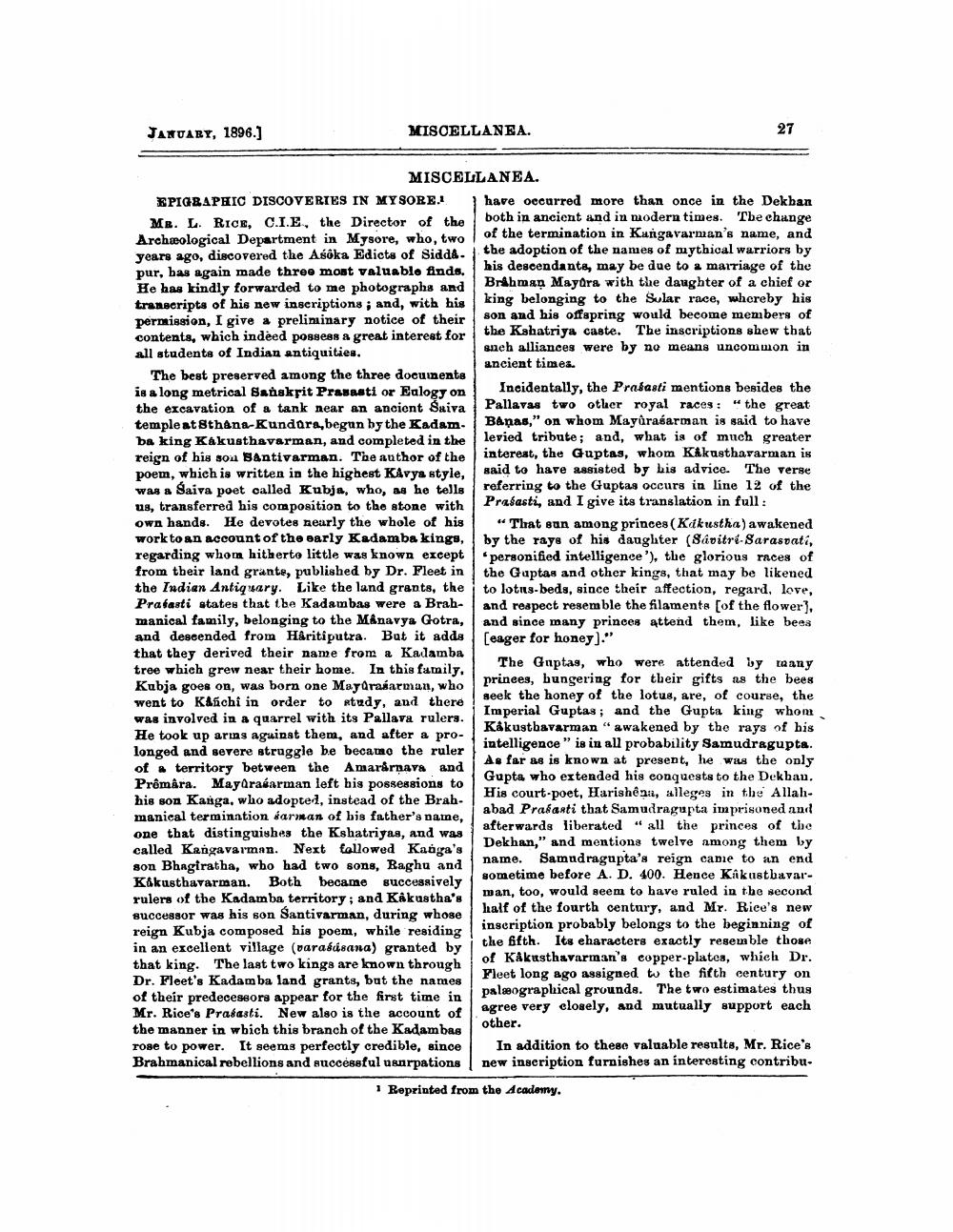________________
JANUARY, 1896.]
MISCELLANEA.
MISCELLANEA.
EPIGRAPHIC DISCOVERIES IN MYSORE. MR. L. RICE, C.I.E, the Director of the Archæological Department in Mysore, who, two years ago, discovered the Asoka Edicts of Sidda. pur, has again made three most valuable finds. He has kindly forwarded to me photographs and transcripts of his new inscriptions; and, with his permission, I give a preliminary notice of their contents, which indeed possess a great interest for all students of Indian antiquities.
The best preserved among the three documents is a long metrical Sanskrit Prasasti or Eulogy on the excavation of a tank near an ancient Šaiva temple at Sthana-Kundara, begun by the Kadamba king Kakusthavarman, and completed in the reign of his son Bantivarman. The author of the poem, which is written in the highest Kavya style, was a Saiva poet called Kubja, who, as he tells us, transferred his composition to the stone with own hands. He devotes nearly the whole of his work to an account of the early Kadamba kings, regarding whom hitherto little was known except from their land grants, published by Dr. Fleet in the Indian Antiquary. Like the land grants, the Prasasti states that the Kadambas were a Brahmanical family, belonging to the Mânavya Gotra, and descended from Hâritiputra. But it adds that they derived their name from a Kadamba tree which grew near their home. In this family, Kubja goes on, was born one Mayarasarman, who went to Kanchi in order to study, and there was involved in a quarrel with its Pallava rulers. He took up arms against them, and after a prolonged and severe struggle be became the ruler of a territory between the Amarârnava and Prêmâra. Mayarasarman left his possessions to his son Kanga, who adopted, instead of the Brahmanical termination sarman of his father's name, one that distinguishes the Kshatriyas, and was called Kangavarman. Next followed Kanga's son Bhagiratha, who had two sons, Raghu and Kakusthavarman. Both became successively rulers of the Kadamba territory; and Kakustha's successor was his son Santivarman, during whose reign Kubja composed his poem, while residing in an excellent village (varasásana) granted by that king. The last two kings are known through Dr. Fleet's Kadamba land grants, but the names of their predecessors appear for the first time in Mr. Rice's Prasasti. New also is the account of the manner in which this branch of the Kadambas rose to power. It seems perfectly credible, since Brahmanical rebellions and successful usurpations
27
have occurred more than once in the Dekhan both in ancient and in modern times. The change of the termination in Kangavarman's name, and the adoption of the names of mythical warriors by his descendants, may be due to a marriage of the Brahman Mayara with the daughter of a chief or king belonging to the Solar race, whereby his son and his offspring would become members of the Kshatriya caste. The inscriptions shew that anch alliances were by no means uncommon in ancient times.
Incidentally, the Prasasti mentions besides the Pallavas two other royal races: "the great Banas," on whom Mayâraéarman is said to have levied tribute; and, what is of much greater interest, the Guptas, whom Kakusthavarman is said to have assisted by his advice. The verse referring to the Guptas occurs in line 12 of the Prasasti, and I give its translation in full:
"That sun among princes (Kakustha) awakened by the rays of his daughter (Savitri Sarasvati, 'personified intelligence'), the glorious races of the Guptas and other kings, that may be likened to lotus-beds, since their affection, regard, love, and respect resemble the filaments [of the flower], and since many princes attend them, like bees [eager for honey]."
The Guptas, who were attended by aany princes, hungering for their gifts as the bees seek the honey of the lotus, are, of course, the Imperial Guptas; and the Gupta king whom Kakusthavarman "awakened by the rays of his intelligence" is in all probability Samudragupta. As far as is known at present, he was the only Gupta who extended his conquests to the Dekhan. His court-poet, Harishêna, alleges in the Allahabad Prasasti that Samudragupta imprisoned and afterwards liberated "all the princes of the Dekhan," and mentions twelve among them by name. Samudragupta's reign came to an end sometime before A. D. 400. Hence Kâkusthavarman, too, would seem to have ruled in the second half of the fourth century, and Mr. Rice's new inscription probably belongs to the beginning of the fifth. Its characters exactly resemble those of Kakusthavarman's copper-plates, which Dr. Fleet long ago assigned to the fifth century on palæographical grounds. The two estimates thus agree very closely, and mutually support each other.
In addition to these valuable results, Mr. Rice's new inscription furnishes an interesting contribu1 Reprinted from the Academy.




